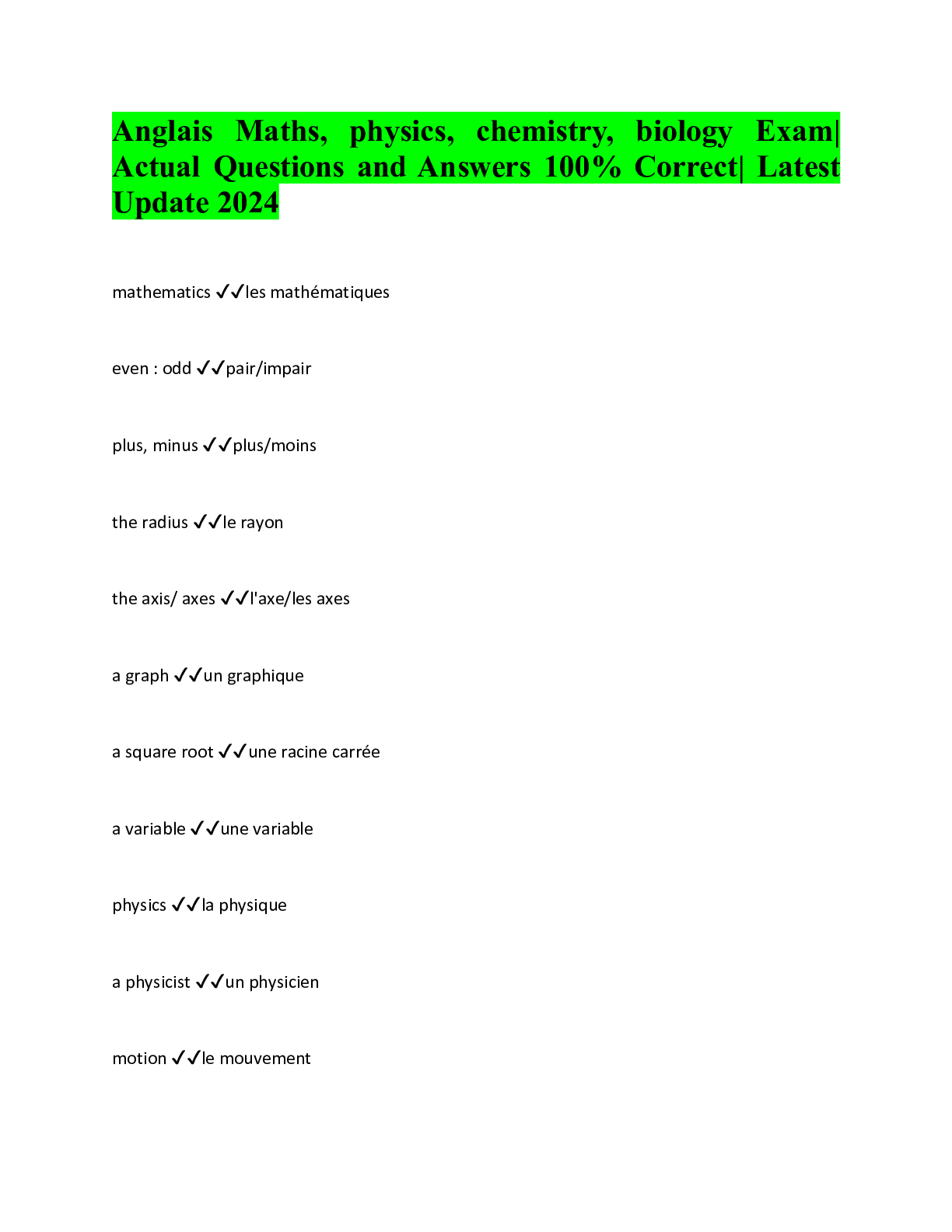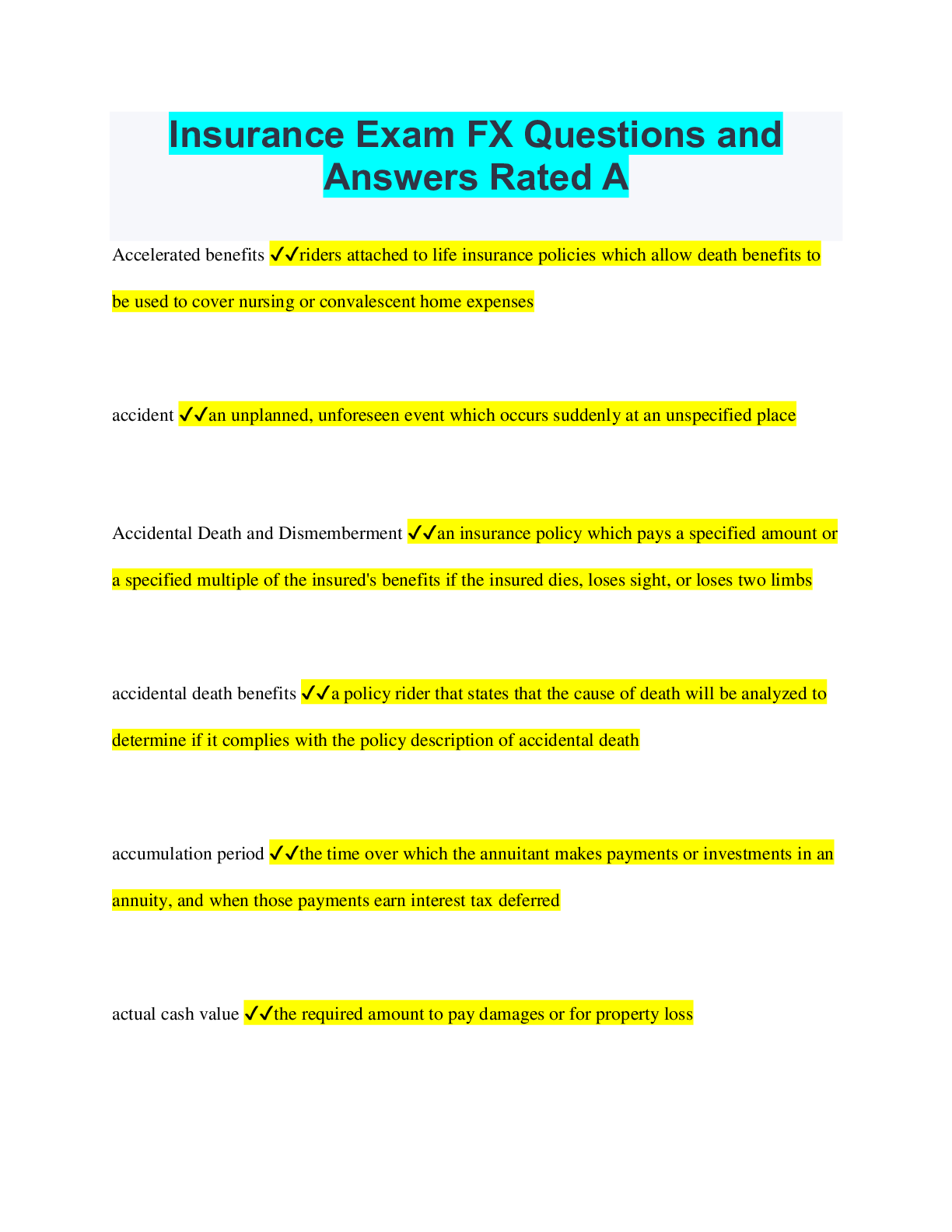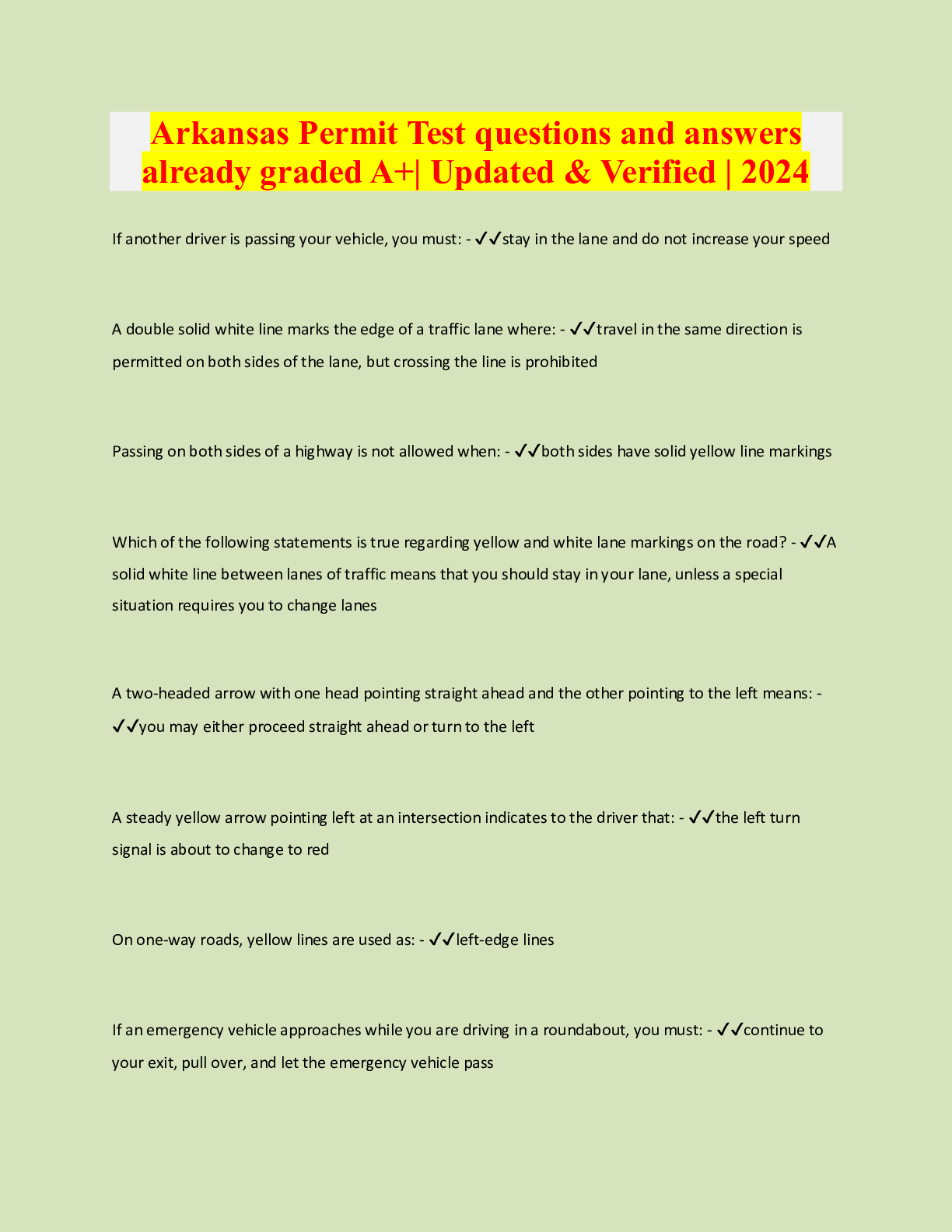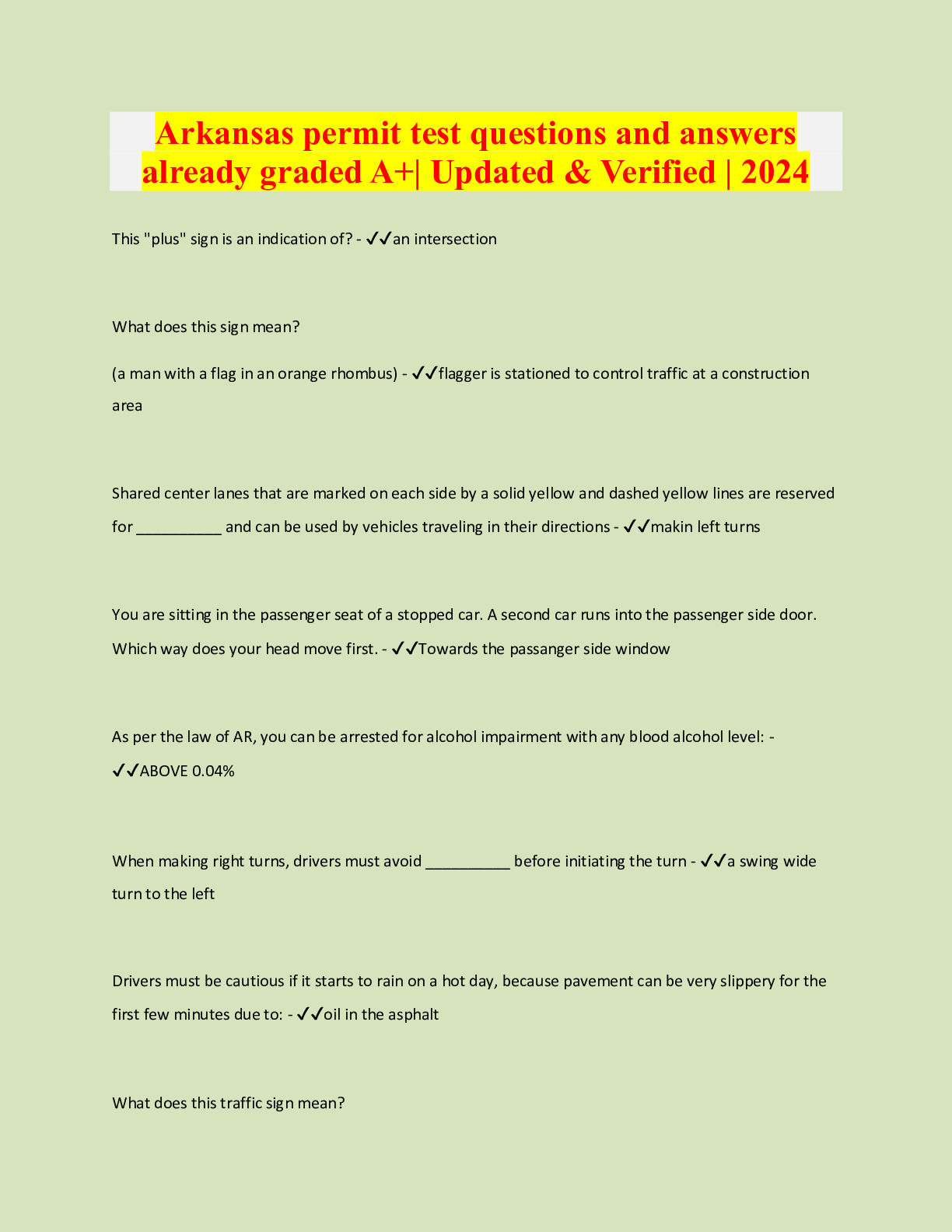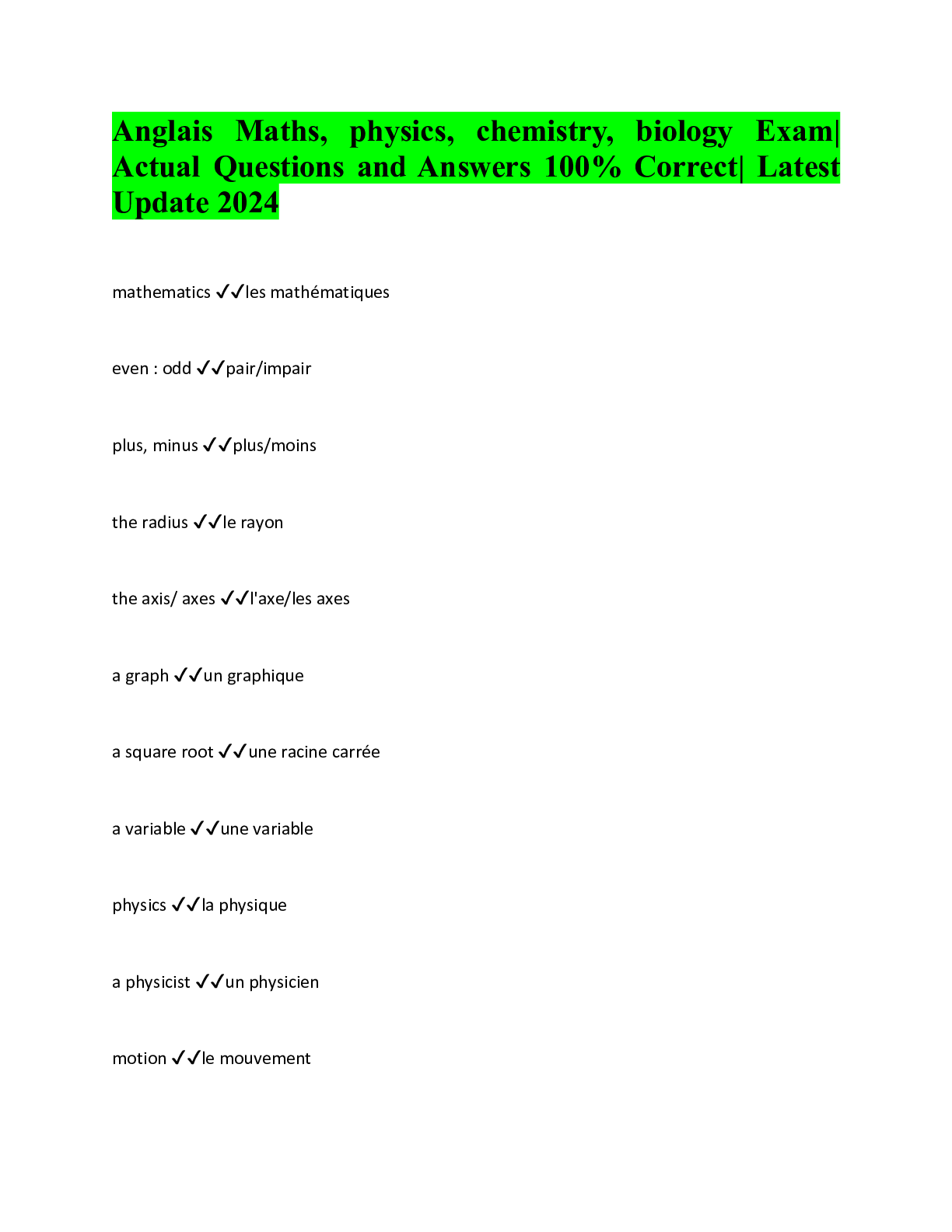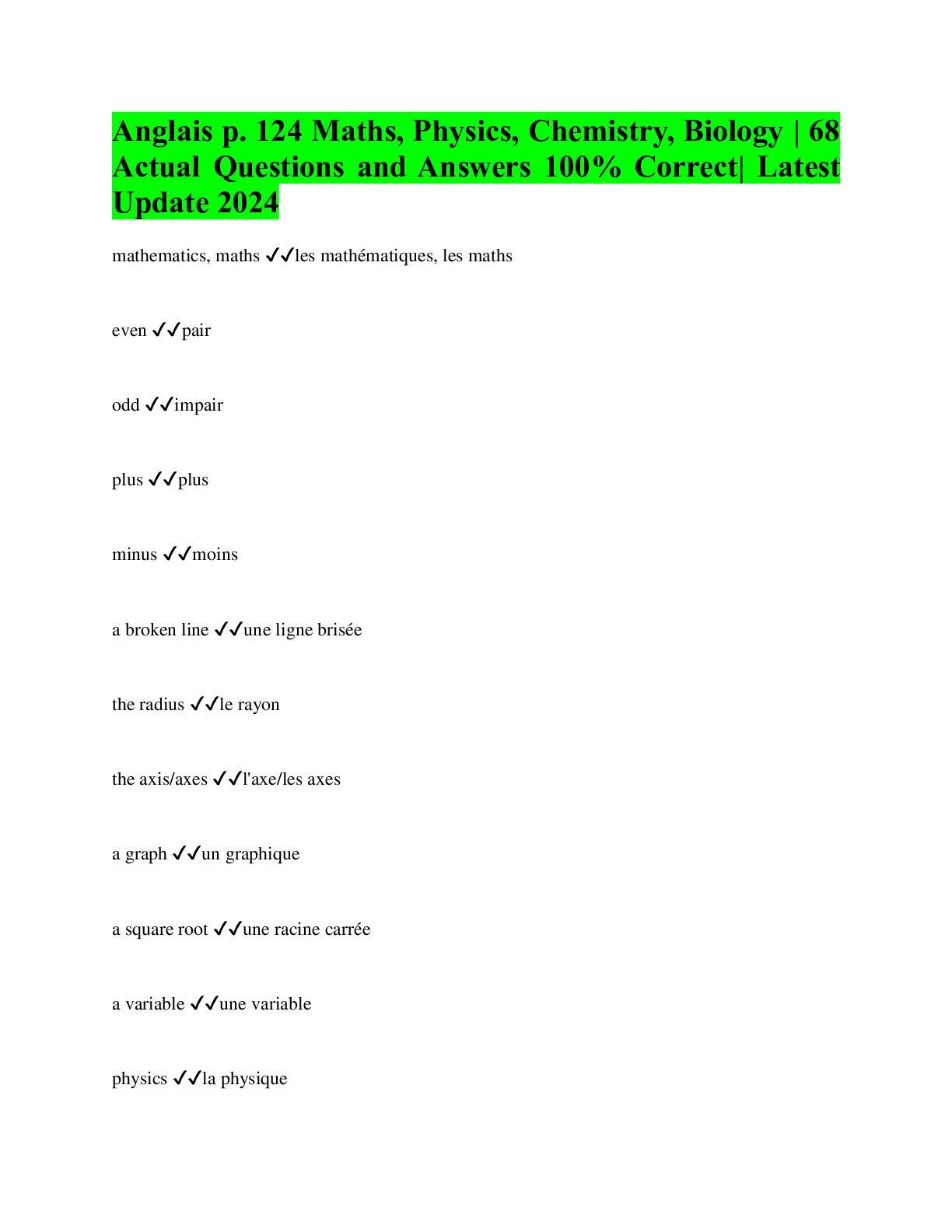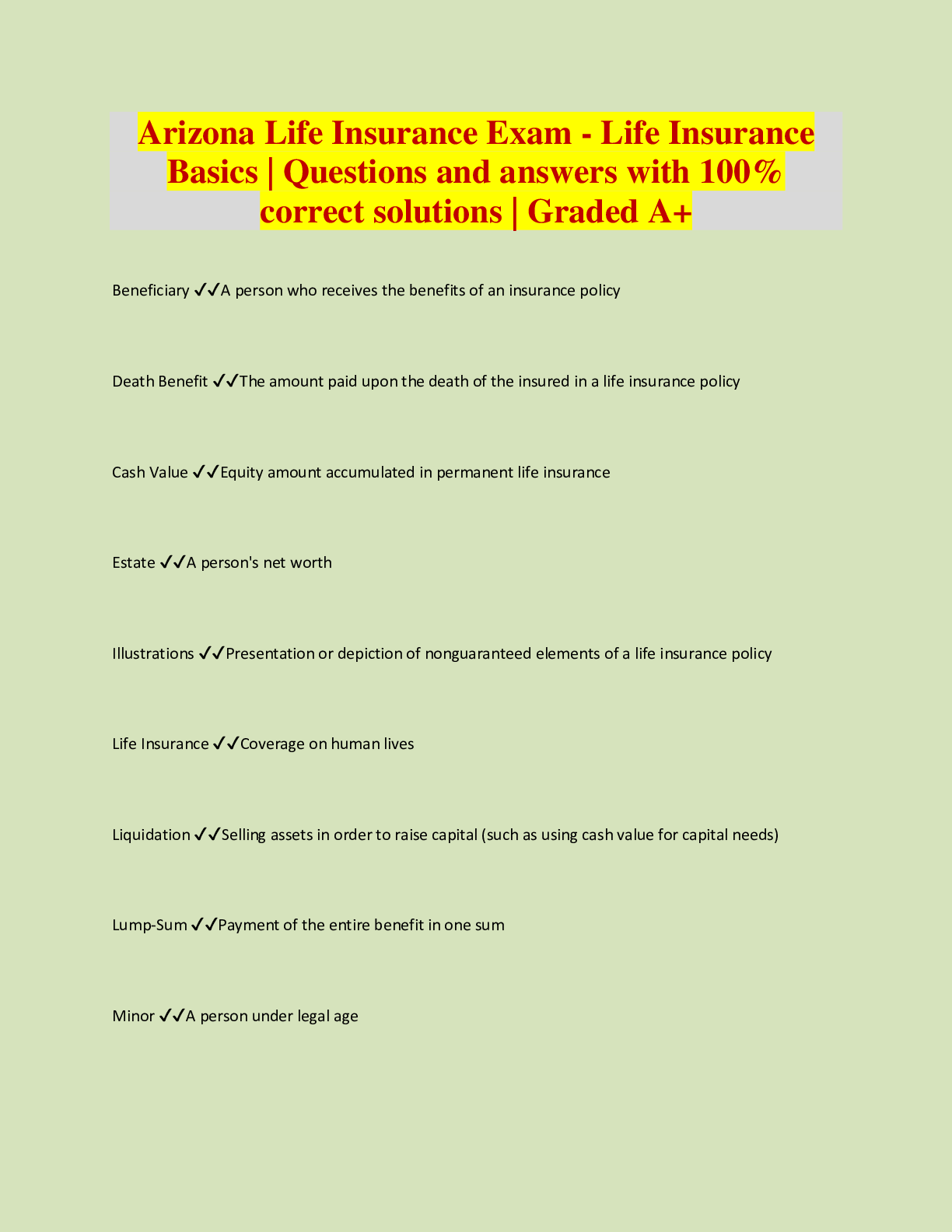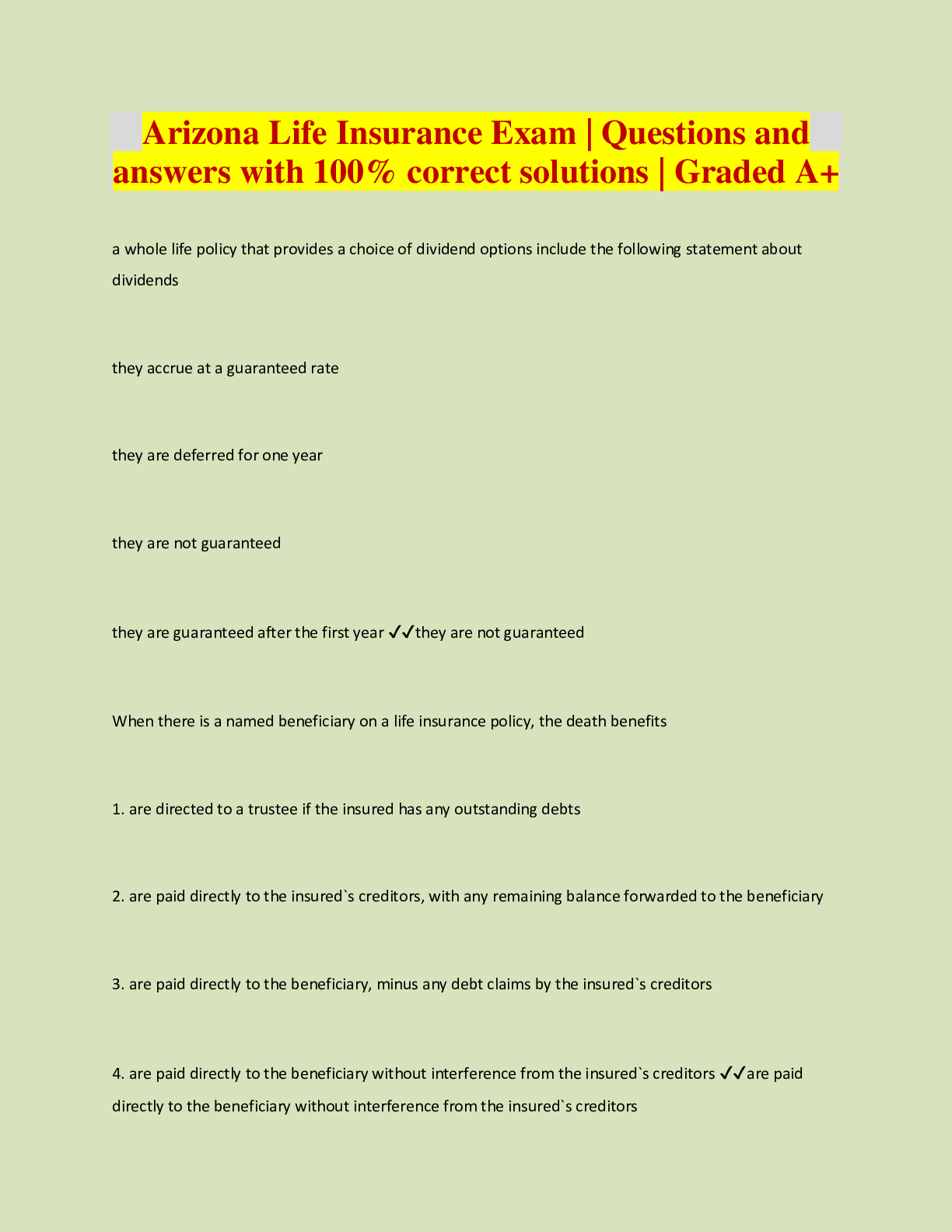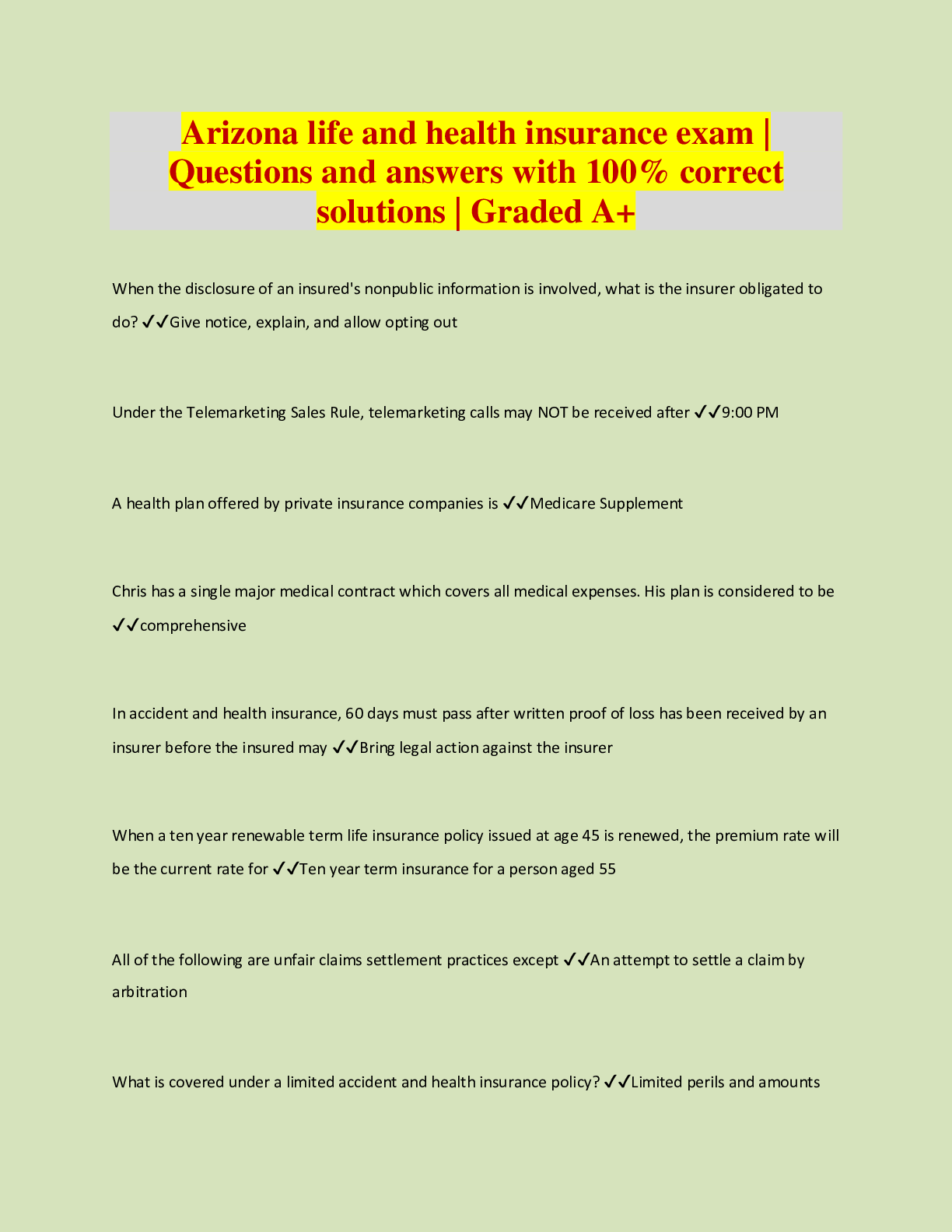Business Management > EXAM > D073 Best Practices in Management Questions and Answers Graded A (All)
D073 Best Practices in Management Questions and Answers Graded A
Document Content and Description Below
Autocratic leader ✔✔One with absolute power. Trait Theory ✔✔"Great Man Theory" Born as a leader Behavioral Theory ✔✔Effective leaders focus on influencing the performance and motivation ... of their employees. Job-Oriented Theory ✔✔Focus on helping employees improve their job performance. Situational Theroy ✔✔Leadership style is adapted to fit the situation of the employee. Emergent Theory ✔✔Leaders emerge naturally from within the group. Holocracy ✔✔Decision making is distributed throughout the team.Contingency Theory ✔✔Predicts that effective leaders are those whose personal traits match the needs of the situation Transactional Theory ✔✔Exchange between two parties. Leadership Style - Anti-change ✔✔Seeks to avoid change. "Stay the course. Keep adjusting small. No need to change in any major way." Leadership Style - Rational ✔✔Focuses on how to constrain and control change with the logical planning and clearly defined steps. Leadership Style - Panacea ✔✔Responds to pressure for change is to communicate and motivate. Have an understanding to the resistance of the change and has enthusiasm for change. Leadership Style - Bolt on ✔✔Regains control of change by attaching change management techniques that create a response to pressure for change. Leadership Style - Integrated ✔✔Use structure and discipline. Understands the culture, roles, capabilities, and attitudes of it's people.Leadership Style - Continuous ✔✔Creates and agile and quick responding organization that can quickly anticipate threats and seize opportunities. Strategic Management Process - 4 stages ✔✔Strategic Objectives, Strategic Formulation, Strategic Implementation, and Strategic Evaluation. Strategic Management Process - Strategic Objective ✔✔SWOT & PESTEL SWOT ✔✔Strength, Weakness, Opportunities, Threats PESTEL ✔✔Political Economic Social Technological Environmental LegalStrategic Management Process - Strategic Formulation ✔✔Goals and Objectives written on the information from SWOT and PESTEL Strategic Management Process - Strategic Implementation ✔✔Planning stops and action begins. Employees know their assignments, responsibilities, and authority. Strategic Management Process - Strategic Evaluation & Control ✔✔Performance measurements to determine progress and milestones. Corrective actions can be used if results are verified from the plan. Competitive Strategies - 3 Types ✔✔Cost Leadership, Differentiation, and Market Segmentation. Competitive Strategy - Cost Leadership ✔✔Ability to create Economies of Scale. Being able to produce a product in a large amount for an efficient price. Competitive Strategy - Differentation ✔✔To create a product or service that is unique and it satisfies a specific target market. Focused on branding.Competitive Strategy - Market Segmentation ✔✔Identifies a specific target group of customers that are not being satisfied by competition. The organization uses both differentiation and cost leadership. This approach describes a company that is focused only on economies of scale. Factors of Cultures - The Paradigm ✔✔Management determines both the mission and vision of the organization and sets the groundwork for the values that employees are expected to align with. Communication is critical. Factors of Cultures - Control Systems ✔✔Behavioral expectations are laid out explicitly for employees to read and understand. Factors of Cultures - Organizational Structures ✔✔Enormous cultural implications for openness of communication, organization of resources, and flow of information. Factors of culture - Power Structures ✔✔Being able (or not) to influence management. Factors of Culture - Rituals and Routines ✔✔Strong behavior Modifiers that significantly impact culture. Looser and open work environment, limited routine and high individual freedom.Factors of Culture - Stories and Myths ✔✔Stories are powerful communicators of culture. Big Five Traits - Openness ✔✔Broad range of interest . Curious about the world and other people. More adventurous and creative. Big five Traits - Conscientiousness ✔✔Goal directed behaviors, organized and mindful f teh details. Big Five Traits - Extraversion ✔✔Sociable, assertive, outgoing, and being around people energizes them. Big Five Trait - Agreeableness ✔✔Trust, kindness, and cooperative. Big Five Traits - Neuroticism ✔✔Sadness, Moodiness, Emotional instability. They experience mood swings, anxiety, and irritability. McClelland's Theory ✔✔Explains an Individuals motivation for learning. Motivated by power seeks out high levels of influenceHerzberg's Two-Factor Theory ✔✔Job satisfaction is influenced by motivator factors, achievement, recognition, and responsibility. Hygiene factors, working conditions, coworkers relations, and policy and rules. Equity Theory ✔✔How is the employee treated in relations to other employees. Vroom Theory ✔✔Employee must value the results and expect their behaviors will result in the achievement of a reward. simple conflict ✔✔conflict over differences in ideas, definitions, perceptions, or goals. pseudo conflict ✔✔the perception that conflict exists when it doesn't ego conflict ✔✔conflict based on personal issues in which people attack each other's selfesteem, personal attacks and character assassinations. Conflict Resolution Strategies - Integrative Approach ✔✔Focus on the issue to be solved and aim to find resolution that meets everyones needs.Conflict Resolution Strategies - Distributive Approach ✔✔Divide a fixed number pf positive outcomes/resources in which one side comes out ahead of another who doesn't get their way today but may end up winning tomorrow. Conflict Resolution Strategies - Mediating Approach ✔✔Bring in a third party to facilitate a non confrontational discussion to help the team reach a consensus about how to resolve the conflict. Smoothing ✔✔Attempts to minimize the difference among the people who conflict with each other. Yielding ✔✔Describes the choice team members make to give in when others disagree with them rather than engage in conflict. Stake is small Avoiding ✔✔Team member may choose to ignore all but most contentious disagreements. 8 Components of the Communication Process- Source ✔✔Person that imagines, creates and sends the message.8 Components of the Communication Process- Message ✔✔The Stimulus or meaning produced by the source for the receiver or audience. 8 Components of the Communication Process- Channel ✔✔How a message travels between the source an the reciever. 8 Components of the Communication Process- Reciever ✔✔Receives the message from the source 8 Components of the Communication Process- Feedback ✔✔When you respond to the source. 8 Components of the Communication Process-Enviroment ✔✔The atmosphere you send and receive the message. 8 Components of the Communication Process- context ✔✔Involves the setting, scene, and expectations of the individuals involved. 8 Components of the Communication Process- Interference ✔✔Anything that blocks or changes the sources's intended meaning of the message.Three Models of Communication - Transmission ✔✔Communication is Linear. one way process in which a sender intentionally transmits a message to a receiver. Three Model Communication - Interactional ✔✔Communication is a process in which participants alternate positions. Instead of one way process this model incorporates feedback. Three Model of Communication - Transaction ✔✔You communicate to create relationships. Competitive Listening ✔✔happens when we are more interested in explaining our own point of view than in understanding someone else's Appreciative Listening ✔✔listening for pleasure or enjoyment Active Listening ✔✔empathetic listening in which the listener echoes, restates, and clarifies. Passive Listening ✔✔listening role in which the listener does not share in the responsibility nor involve himself in the communication processCombative Listening ✔✔When a person listens very intently to senders messages for the purpose of attacking them, often by using their own words against them as soon as they are finished speaking. Kolb Learning Cycle- Step One ✔✔Experience - The thing that happened Kolb Learning Cycle - Step Two ✔✔Publishing - Participants reflect on themselves Kolb Learning Cycle - Step Three ✔✔Processing - Participants reflect on observations of others who shared the experience. Kolb Learning Cycle - Step Four ✔✔Generalizing - Participants work to relate the experience to other aspects of their life. Kolb Learning Cycle - Step Five ✔✔Applying - Participants consider how they can apply the results of the experience in the future. SMART Goals ✔✔SpecificMeasurable Attainable Realistic Time-bound Smart - Specific ✔✔Focused, defined, Clear. Objective should identify the expected actions and outcomes. 5 w' What do I want to accomplish? Why is this goal important? Who is involved? Where is it located? Which resources or limits are involved? sMart - Measurable ✔✔Keeps you focused and Motivated. 3 H'sHow much? How many? How will I know when it's accomplished?smArt - Achievable ✔✔Crucial for all Stakeholders. Must be attainable. smaRt - Relevant ✔✔Your goal aligns with the company's mission smarT - Time bound ✔✔Having a schedule or deadline. They will help increase productivity and prevent work from dragging on. salient ✔✔Information relates to a particular context that makes it meaningful and relvant. Mission ✔✔What a Company does well Vision ✔✔What a company would like to do well Values ✔✔What a company thinks is important Long Range Planning ✔✔Helps companies determine where they want to be. "Big Picture" Controlling ✔✔Evaluation and corre [Show More]
Last updated: 9 months ago
Preview 4 out of 12 pages

Loading document previews ...
Buy this document to get the full access instantly
Instant Download Access after purchase
Buy NowInstant download
We Accept:

Reviews( 0 )
$10.00
Can't find what you want? Try our AI powered Search
Document information
Connected school, study & course
About the document
Uploaded On
Sep 09, 2024
Number of pages
12
Written in
Additional information
This document has been written for:
Uploaded
Sep 09, 2024
Downloads
0
Views
12

